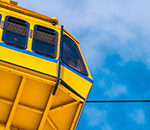Vivian Maier was a private person. She lied about her name, she locked her doors. She never showed her photographs to anyone. Shortly before her death in 2009, when Chicago historian John Maloof uncovered over 100,000 of her negatives and rolls of undeveloped film at a local auction, her name quickly discovered the fame and notoriety in death that she had shied away from for her whole life. Her photographs have since been exhibited throughout the US and Europe, published in newspapers, and even compiled into the 2011 book Vivian Maier: Street Photographer. Now, Maloof is creating a documentary to explore this incredible enigma, Finding Vivian Maier, see here:
Because she was so intensely secluded, details of Maier’s life are spotty at best. Through much investigation, it was discovered that she was born in New York and spent much of her childhood living in France. At 25, she moved back to New York where she worked in a sweatshop before making her way to Chicago, whose streets bore most of her images.
For the next 40 years, she worked as a nanny, giving tender care for different families (including a breif stint in Phil Donahue’s house). In her spare time, she would wander the streets and avenues, capturing the fleeting scenes of city life amongst which she lived so quietly.
During her thirties, Maier traveled the world, creating photographs of Egypt, Bangkok, Beijing, Manila, and the American Southwest, including Los Angeles. She was drawn to the grittiness of the down-and-out sections of society, the marginalized and persecuted, and was likely homeless herself for a period after retiring. She was described by the children she cared for as an outspoken feminist, even a socialist, and never afraid to tell the harsh truth; this comes through in her photographs.
Her go-to camera for most of her life was a Rolleiflex twin-lens reflex, which created her iconic square-framed medium-format pictures. She was an anti-materialist, and compulsively hoarding boxes of old newspapers, audio recordings, and of course, her negatives. Her passion for documenting history even extended into film, and she would create amateur videos which recorded the changing world around her.
Through this portrait of a fiercely reclusive and deeply insightful woman, we see the character of the solitary artist – one who creates purely and completely for her own need, the development of her own vision, without ever wanting her deepest soul to be influenced by outside opinions or forces. Vivian Maier was an island, blossoming uniquely alone; when her work saw the light of day, it shone with the untouched brilliance of the Galapagos, full of beautiful unseen creatures and faded history that, thanks to her, are not lost to the world.
Like This Article?
Don't Miss The Next One!
Join over 100,000 photographers of all experience levels who receive our free photography tips and articles to stay current:








Simply brilliant! My son bought me her book last year for Christmas and I my opinion, she is the greatest Street Photographer ever!